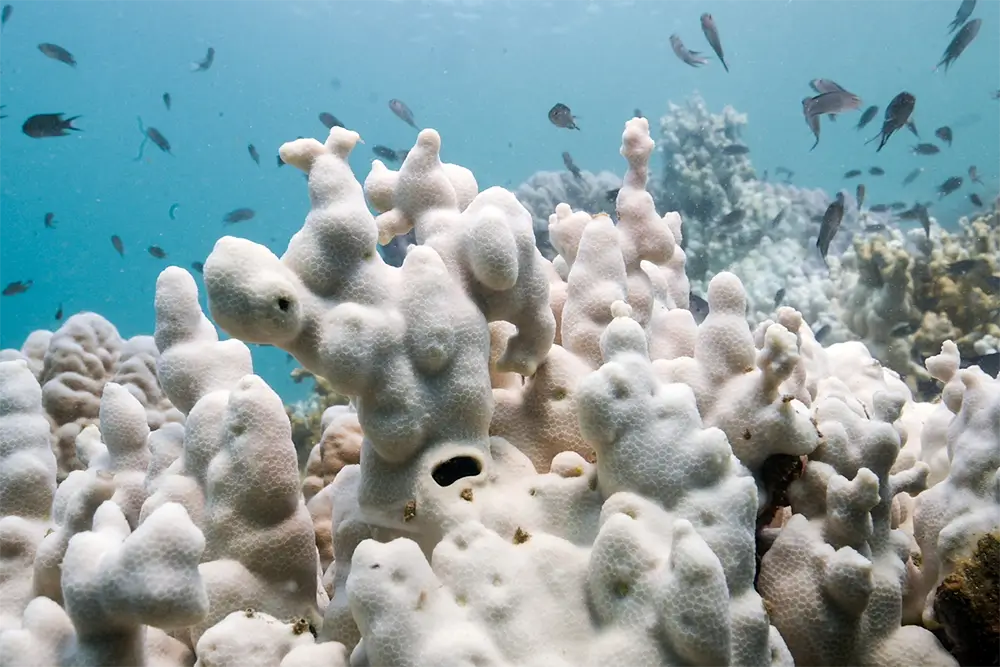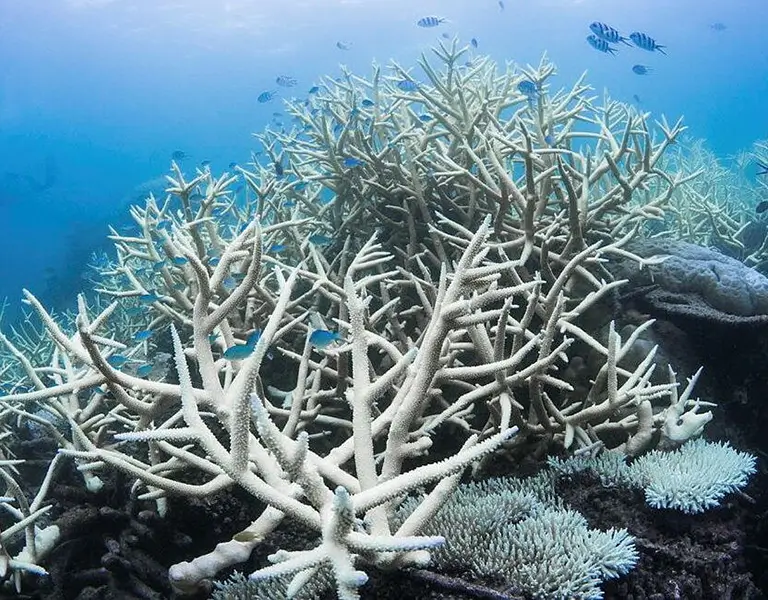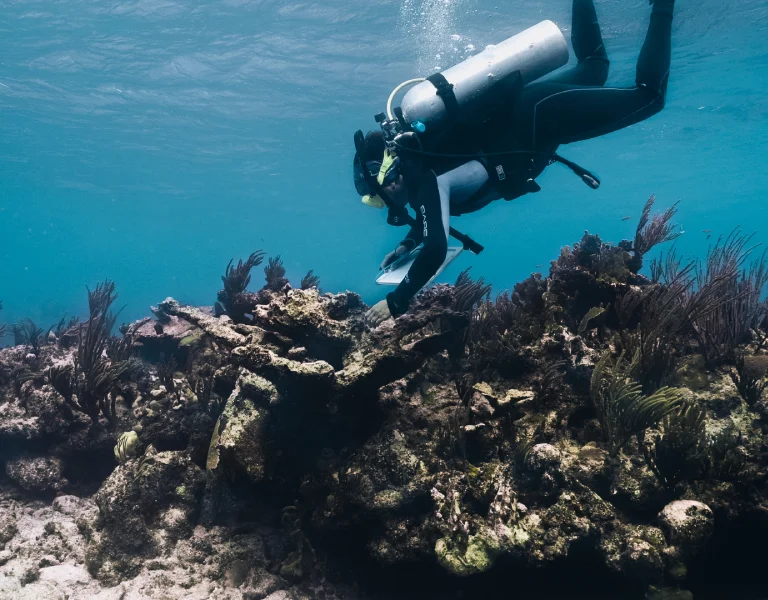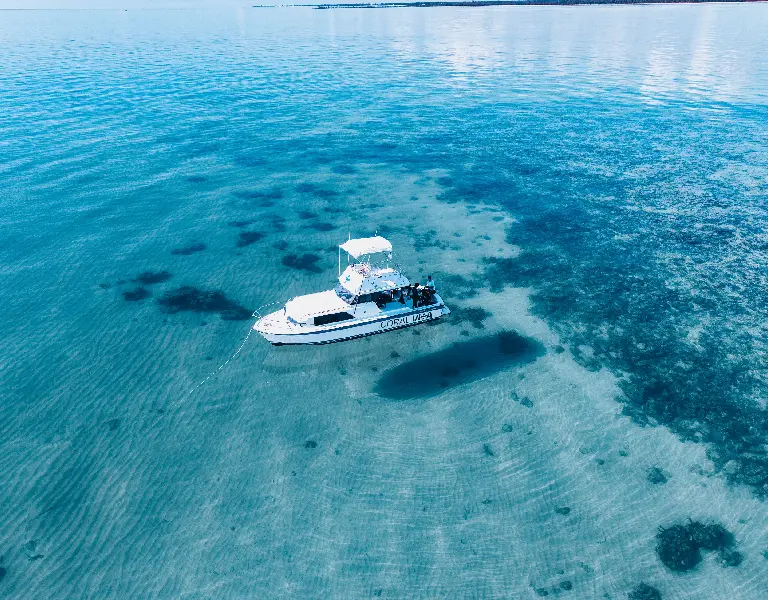Scientists track climate change indicators to measure Earth’s vital signs, revealing trends that directly impact ocean ecosystems and coastal communities. Understanding these measurements empowers meaningful action toward protecting marine environments and building resilience.
Key Takeaways
- Global surface temperatures exceeded 1.5°C above pre-industrial levels for the first time in 2024, with direct consequences for coral reef ecosystems.
- Sea level rise has accelerated to 4.35 mm per year, more than double the rate from the early 1990s.
- Ocean heat content has set new records for eight consecutive years, driving mass coral bleaching events.
- Supporting a regenerative blue economy through reef conservation offers tangible pathways to address ecological and community needs.
The Science Behind Climate Change Indicators
Climate change indicators are measurable benchmarks tracking how our planet responds to rising greenhouse gas emissions. The 2025 Indicators of Global Climate Change report, compiled by over 60 scientists from 17 countries, represents the latest assessment of our planet’s vital signs.1 These findings reveal accelerating change across multiple Earth systems.
Temperature Trends: Breaking Critical Thresholds

Data from 2024 confirmed that global average surface temperatures reached 1.6°C above pre-industrial levels, crossing the 1.5°C threshold set by the Paris Agreement.2 Each of the last ten years ranked among the ten warmest on record, an unprecedented pattern in the instrumental record.3
For coral reefs, temperature spikes of just 1 to 2°C above normal trigger coral bleaching, where corals expel their symbiotic algae.4 The 2015-2017 bleaching events killed nearly half of the Great Barrier Reef, and we’re currently experiencing the fourth global mass bleaching event.
Ocean-Specific Indicators
Rising Seas
Sea level rise stands at 4.35 mm per year, more than double the 2.1 mm annual rate from 1993 to 2002.5 Between 1901 and 2024, global sea levels rose 23 cm. This acceleration stems from thermal expansion of warming seawater and ice melt from Greenland and Antarctica.6
Ocean Heat Content
The ocean’s top 700 meters have set heat content records for eight consecutive years.7 Ocean temperatures surrounding the Coral Triangle are warming at 0.09 to 0.12°C per decade, with projections of 1 to 4°C increases by century’s end.8 Warming exceeding 2°C would eliminate most coral reef systems supporting over 100 million people.
Ocean Acidification
With atmospheric carbon dioxide at 151% of preindustrial levels, oceans absorb roughly 30% of these emissions.9 This creates ocean acidification, reducing pH levels and making it harder for corals to build their calcium carbonate skeletons. For coral reef ecosystems, warming and acidification create a dual threat to survival.
Greenhouse Gas Emissions: The Root Cause
Carbon dioxide emissions from fossil fuels and industry reached 38.2 billion tonnes in 2024, while land-use change emissions hit 4.2 billion tonnes.10 Methane levels reached 265% of preindustrial concentrations. These emissions persist for centuries, meaning today’s actions influence climate change indicators for generations.
The regenerative blue economy offers pathways to address emissions while supporting ocean health through marine ecosystem restoration and sustainable economic activities.
What Climate Change Indicators Mean for Coral Reefs
Scientists warn that warming exceeding 1.5°C could cause loss of over 90% of coral reefs by 2050, with 99% decline projected at 2°C.11 Coral reefs support over 500 million people through food security, coastal protection, tourism, and cultural heritage.12 Their economic value reaches $1 trillion annually, with climate-related losses potentially costing $500 billion yearly by 2100.
Healthy coral ecosystems contribute to climate resilience by reducing wave energy by 97%, protecting shorelines from erosion and storms. They support fisheries, filter water, and store carbon in limestone structures.
Building Resilience Through Restoration

Land-based coral farming can produce diverse coral species while researching climate adaptation. Scientists identify coral genotypes with greater heat and acidification tolerance, helping reefs adapt to future conditions predicted by climate change indicators. While not a complete solution, restoration represents an essential response component.
The Regenerative Blue Economy Framework
The regenerative blue economy moves beyond sustaining ocean resources to actively restoring marine ecosystems.13 This framework prioritizes reef rehabilitation, mangrove replanting, and seagrass recovery while excluding extractive practices like offshore oil drilling.
This approach emphasizes participatory governance centering coastal and indigenous communities who bear the brunt of changes while holding generations of sustainable living wisdom. Successful projects unite scientific knowledge with local expertise.
The regenerative blue economy creates diverse, sustainable coastal income through restoration work, ecotourism, and nature-positive enterprises. Financial mechanisms like blue bonds and payments for ecosystem services direct capital toward projects generating ecological and community benefits. For island nations where ocean resources represent substantial GDP portions, reef restoration becomes an economic imperative.14
Technology and Innovation

Satellite systems now track sea surface temperatures, bleaching risk, and ecosystem health indicators. Advances in coral cultivation accelerate restoration, while machine learning analyzes genetic data to identify coral lineages suited for future conditions.
These technologies create adaptation tools while we address root causes. Reducing greenhouse gas emissions remains essential, but innovation helps ecosystems and communities manage changes already underway.
The Path Forward
Climate change indicators provide crucial information, but bridging the gap between understanding and action remains essential. Supporting reef restoration through coral adoption programs, volunteering, or spreading awareness contributes to regenerative efforts. Reducing personal carbon footprints addresses underlying drivers.
The High Seas Treaty aims to place 30% of oceans into marine protected areas with clear activity rules.15 Supporting such initiatives alongside renewable energy transitions and coastal protection creates systemic change.
Conclusion
Climate change indicators reveal unprecedented ocean pressures from warming, acidification, and sea level rise threatening coral reefs and hundreds of millions of people. Yet within this challenge lies opportunity.
Understanding these indicators enables purposeful response. Reef restoration, the regenerative blue economy, and community-centered conservation offer pathways forward. While we cannot immediately reverse global trends, we can build resilience in ecosystems and communities. Every restored coral, protected marine area, and shift toward regenerative economics makes a difference.
The indicators will continue evolving, some worsening before improvement. But through informed action, innovation, and genuine commitment to ocean health, we can work toward a future where coral reefs thrive and coastal communities prosper.
About Coral Vita
Coral Vita is a mission-driven company dedicated to restoring our world’s dying and damaged reefs. Using innovative land-based farming techniques, Coral Vita grows diverse and resilient corals in months instead of the decades they take in nature. These corals are then transplanted into threatened reefs, helping to preserve ocean biodiversity while protecting coastal communities that depend on healthy reefs for protection, food, and income.
Founded by environmental entrepreneurs Sam Teicher and Gator Halpern, Coral Vita’s high-tech coral farms incorporate breakthrough methods to restore reefs in the most effective way possible. In 2021, the company was recognized as the inaugural winner of Prince’s William’s Revive Our Oceans Earthshot Prize Winner for their pioneering work in coral restoration.
To learn more about Coral Vita’s work or to get involved in coral reef conservation efforts, visit their website at www.coralvita.co or contact them directly through their Contact Us page.
Frequently Asked Questions
What are the most important climate change indicators to monitor for ocean health?
Ocean temperature, sea level rise, and ocean acidification represent the most critical indicators for marine ecosystem health. These measurements directly impact coral reefs, fisheries, and coastal communities, providing early warning signs of ecosystem stress.
How do climate change indicators affect coral reef ecosystems specifically?
Rising ocean temperatures trigger coral bleaching events, while ocean acidification weakens coral skeletons and reduces growth rates. Together, these indicators reveal conditions that threaten the survival of coral reef ecosystems and the hundreds of millions of people who depend on them.
What is the regenerative blue economy and how does it relate to climate indicators?
The regenerative blue economy prioritizes ocean ecosystem restoration and sustainable marine activities over extraction-based approaches. By addressing challenges revealed by climate change indicators through restoration and community-centered solutions, it offers pathways to build both ecological and economic resilience.
Can coral reef restoration make a difference given current climate change indicator trends?
While restoration alone cannot reverse global warming, it builds critical resilience in reef ecosystems and coastal communities. Restored reefs provide coastal protection, support biodiversity, and create opportunities to study and enhance coral adaptation to changing ocean conditions revealed by climate indicators.
References
- https://essd.copernicus.org/articles/17/2641/2025/ ↩︎
- https://www.axios.com/2025/03/19/climate-change-indicators-records-global-warming ↩︎
- https://www.epa.gov/climate-indicators ↩︎
- https://oceanservice.noaa.gov/facts/coralreef-climate.html ↩︎
- https://www.climatechangebh.org.uk/perspectives/indicators-of-global-climate-change-2025-review ↩︎
- https://science.nasa.gov/earth/climate-change/vanishing-corals-nasa-data-helps-track-coral-reefs/ ↩︎
- https://www.axios.com/2025/03/19/climate-change-indicators-records-global-warming ↩︎
- https://wwf.panda.org/discover/knowledge_hub/where_we_work/coraltriangle/problems/climatechangecoraltriangle/ ↩︎
- https://www.axios.com/2025/03/19/climate-change-indicators-records-global-warming ↩︎
- https://essd.copernicus.org/articles/17/2641/2025/ ↩︎
- https://www.wwf.org.uk/coral-reefs-and-climate-change ↩︎
- https://iucn.org/resources/issues-brief/coral-reefs-and-climate-change ↩︎
- https://iucn.org/news/202404/new-iucn-report-shows-way-toward-regenerative-blue-economy ↩︎
- https://www.axios.com/2025/03/19/climate-change-indicators-records-global-warming ↩︎
- https://www.lse.ac.uk/granthaminstitute/explainers/what-is-the-blue-economy/ ↩︎







